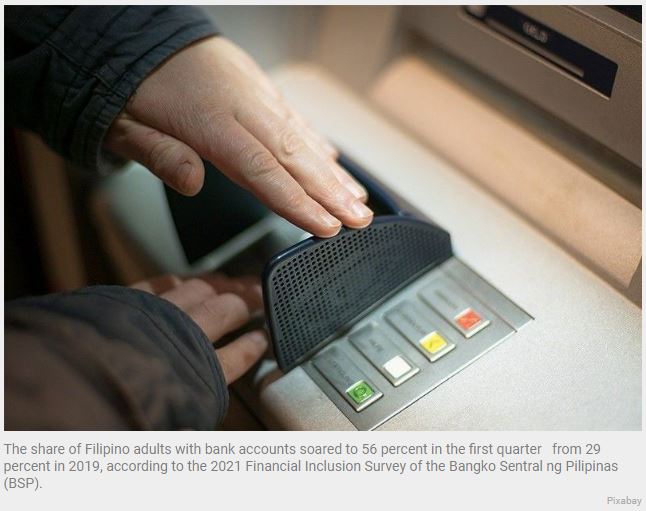Filipino adults with bank accounts jump to 56%
MANILA, Philippines — The share of Filipino adults with bank accounts soared to 56 percent in the first quarter from 29 percent in 2019, according to the 2021 Financial Inclusion Survey of the Bangko Sentral ng Pilipinas (BSP).
The number of Filipino adults with bank accounts doubled to 42.9 million from 20.9 million, translating to an additional 22 million accounts opened between 2019 and 2021.
Consequently, the number of Filipinos without an account dropped to 34.3 million from 51.2 million.
Compared with ASEAN countries, the percentage of Filipino adults with an account in 2021 was higher than Cambodia’s 33 percent, Laos’ 37 percent, Myanmar’s 48 percent, and Indonesia’s 52 percent, but lower than Malaysia’s 88 percent, Thailand’s 96 percent, and Singapore’s 98 percent, based on the 2021 World Bank Global Findex.
BSP Governor Felipe Medalla said the expansion in the number of Filipino adults was spurred by the pandemic, which accelerated the use of digital payments.
“Amid the latest figures, the BSP will continue to broaden its efforts to foster the wider adoption of digital technology, which has effectively enabled the onboarding of more Filipinos into the formal financial system,” Medalla said.
The increase last year was the highest two-year growth since the survey began in 2015. Adult population in the Philippines is estimated at 77.2 million in 2021.
The rise of account ownership was attributed to the uptake of e-money accounts, which jumped to 36 percent last year from eight percent in 2019.
This became the most common type of account among adults in the middle class and low-income population, as well as with those aged 15 to 49 years old.
Likewise, the share of adults with a bank account almost doubled to 23 percent from 12 percent with banks remaining the preferred formal institution for saving money by a third of those with savings, followed by cooperatives and microfinance institutions.
According to the FIS, six out of 10 Filipinos altered their financial behavior during the pandemic.
Filipinos started saving more for emergencies at 37 percent, began or increased their usage of online banking and digital payments at 17 percent, and borrowed more at 15 percent.
Filipino adults with mobile phones and internet access in 2021, about 60 percent performed financial transactions online, such as fund transfers and payments.
However, challenges remain for the financial inclusion agenda.
The BSP said the main barriers to account ownership, such as lack of income and transaction costs persist. In addition, the lack of documents to open an account is still prevalent for a large segment of the population. Moreover, the survey found that over half of savers still keep their money at home.
The central bank said these challenges, more pronounced among lower income groups, highlight the importance of strengthening mechanisms to support the financial resilience of the vulnerable segments of the population.
“With the National Strategy for Financial Inclusion 2022-2028, the BSP continues to work not only with other government agencies, but also with private sector and development partners to achieve our shared vision of accelerating financial inclusion toward broad-based growth and financial resilience,” Medalla said.
Under its Digital Payments Transformation Roadmap, the BSP aims to raise the number of Filipino adults with bank accounts to 70 percent by 2023.
Aside from increasing the number of banked Filipino adults, the central bank also intends to raise the share of digital payments to total retail transactions to 50 percent by 2023.
With the pandemic serving as catalyst, the share of electronic payments to total retail transactions went up by 30.3 percent in 2021 from 20.1 percent in 2020.
Source: https://www.philstar.com/business/2022/08/24/2204606/filipino-adults-bank-accounts-jump-56


 English
English




